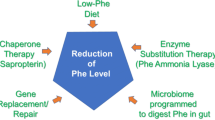Abstract
Purpose
Acute porphyrias are metabolic disorders of heme biosynthesis characterized by acute life-threatening attacks. The diagnosis is often missed since clinical presentation is aspecific mimicking other medical and surgical conditions. Variegate porphyria (VP) is an autosomal dominant inherited disease with incomplete penetrance due to decreased activity of the Protoporphyrinogen Oxydase (PPOX) gene; most VP mutations are family specific. We report the case of a 40 year-old woman who presented many times to the emergency department complaining of unexplained abdominal pain and laboratory investigations showed repeatedly hyponatremia. Syndrome of inappropriate antidiuresis (SIAD) was confirmed and measurement of urine porphobilinogen and delta-aminolevulinic acid disclosed the diagnosis of acute porphyria. The genetic analysis of PPOX gene was performed.
Methods
The entire coding sequence and exon/intron boundaries of PPOX gene were amplified in 5 different Polymerase Chain Reaction (PCR) fragments. In silico prediction of the pathogenicity of the mutation was determined by using different tools, Polyphen2, SNPs&GO, SNPs3D.
Results
The genetic analysis of PPOX gene revealed a novel missense variant c.1376 G > A (p.Cys459Tyr) in heterozygous state. The same variant was later found in one of her cousins with skin lesions and other three younger asymptomatic relatives. We provided evidence that this novel mutation is likely to be pathogenetic.
Conclusions
Our case highlights the importance of considering VP in the differential diagnosis of SIAD and underlines the role of genetic screening in the management of such patients. The finding of a novel mutation of PPOX gene in our index case has allowed to recognize an affected family.

Similar content being viewed by others
References
K.E. Anderson, J.R. Bloomer, H.L. Bonkovsky, J.P. Kushner, C.A. Pierach, N.R. Pimstone, R.J. Desnick, Recommendations for the diagnosis and treatment of the acute porphyrias. Ann. Intern. Med. 142, 439–450 (2005)
P.E. Stein, M.N. Badminton, D.C. Rees, Update review of the acute porphyrias. Br. J. Haematol. 176(4), 527–538 (2017)
R.E. Kirsch, P.N. Meissner, R.J. Hift, Variegate porphyria. Semin. Liver. Dis. 18(1), 33–41 (1998)
D. Schulenburg-Brand, R. Katugampola, A.V. Anstey, M.N. Badminton, The cutaneous porphyrias. Dermatol. Clin. 32(3), 369–384 (2014)
E. Pischik, R. Kauppinen, An update of clinical management of acute intermittent porphyria. Appl. Clin. Genet. 8, 201–214 (2015)
M.T. Tébar, L. Aguilera, Acute intermittent porphyria and inappropriate ADH syndrome. Rev. Esp. Anestesiol. Reanim. 57(5), 311–313 (2010)
Y. Li, H. Qu, H. Wang, H. Deng, Z. Liu, Novel A219P mutation of hydroxymethylbilane synthase identified in a Chinese woman with acute intermittent porphyria and syndrome of inappropriate antidiuretic hormone. Ann. Hum. Genet. 79(4), 310–312 (2015)
X. Qin, Y. Tan, L. Wang, Z. Wang, B. Wang, X. Wen, G. Yang, Z. Xi, Y. Shen, Structural insight into human variegate porphyria disease. Faseb. J. 25(2), 653–664 (2011)
P. Ventura, M.D. Cappellini, G. Biolcati, C.C. Guida, E. Rocchi, Gruppo Italiano Porfiria (GrIP). A challenging diagnosis for potential fatal disease: recommendations for diagnosing acute porphyrias. Eur. J. Inter. Med. 25(6), 497–505 (2014)
G. Spasovski, R. Vanholder, B. Allolio, D. Annane, S. Ball, D. Bichet, G. Decaux, W. Fenske, E.J. Hoorn, C. Ichai, M. Joannidis, A. Soupart, R. Zietse, M. Haller, S. van der Veer, W. Van Biesen, E. Nagler, Clinical practice guideline on diagnosis and treatment of hyponatremia. Nephrol. Dial. Transplant. 29(Suppl 2), i1–i39 (2014)
C.C. Yang, H.C. Kuo, H.L. You, J. Wang, C.C. Huang, C.Y. Liu, M.Y. Lan, D.A. Stephenson, M.J. Lee, HMBS mutations in Chinese patients with acute intermittent porphyria. Ann. Hum. Genet. 72(Pt 5), 683–686 (2008)
T. Miyaoka, H. Seno, M. Itoga, T. Kishi, H. Ishino, J. Horiguchi, Contribution of sodium valproate to the syndrome of inappropriate secretion of antidiuretic hormone. Int. Clin. Psychofarmachol. 16(1), 59–61 (2001)
A. Nabin, L.J. Thapa, R. Paudel, P.V.S. Rana, Acute intermittent porphyria with SIADH and fluctuating Dysautonomia. Kathmandu Univ. Med. J. 38(2), 96–99 (2012)
S. Zhou, X. Zhao, H. Kang, R. Xu, Y. Yu, J. Zheng, M. Pan, Novel heterozygous mutation of protoporphyrinogen oxidase gene in a Chinese patient with variegate porphyria. J. Dermatol. (2017) https://doi.org/10.1111/1346-8138.13982
Author information
Authors and Affiliations
Corresponding author
Ethics declarations
Conflict of interest
The authors declare that they have no conflict of interest.
Informed consent
Informed consent was obtained from all individual participants included in the study.
Rights and permissions
About this article
Cite this article
Tabaro, I., Reimondo, G., Osella, G. et al. Novel mutation of PPOX gene in a patient with abdominal pain and syndrome of inappropriate antidiuresis. Endocrine 61, 403–406 (2018). https://doi.org/10.1007/s12020-018-1569-5
Received:
Accepted:
Published:
Issue Date:
DOI: https://doi.org/10.1007/s12020-018-1569-5




